六、 cube.AI将训练模型转换为c语言模型
6.1 创建cube.AI支持的STM32工程
在CubeIDE中新建一个STM32项目,在cubeMX中选择以开发板形式创建
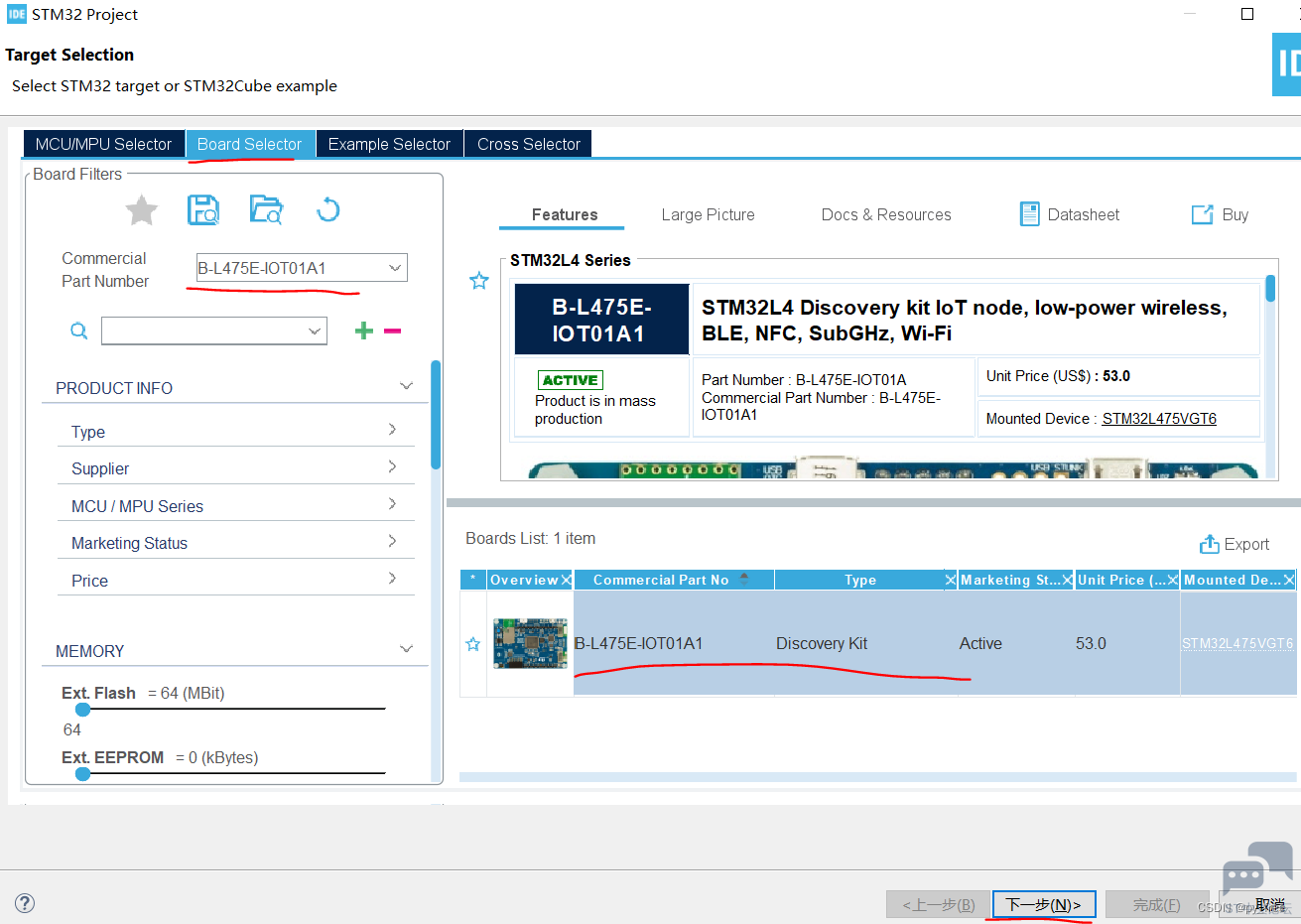
创建一个B-L475E-IOT01A_cube.ai工程名的STM32工程,如下图。
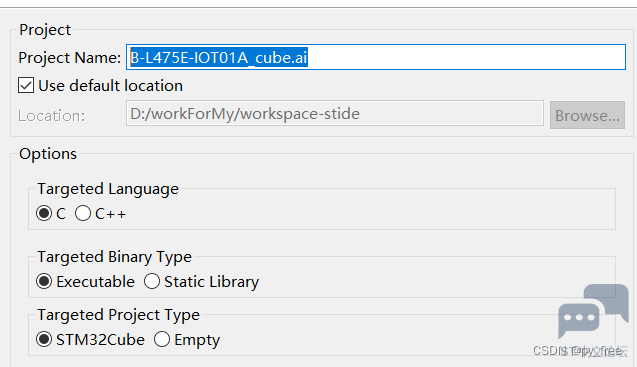
完成创建后,双击.ioc文件打开cube.MX配置界面。

6.2 cube.AI神经网络配置
选择X-CUBE-AI包支持,回到主页面后,会多出software Packs栏及多出STMicroelectronics .X-CUBE-AI选项,进入该页面,勾选下图标识的2、3 项,在5中选择采用哪个串口支持程序及调试。

知识点,在X-CUBE-AI配置选项页面,停靠时,会出现说明框,快捷键“CTRL+D”会进一步出现X-CUBE-AI相关文档,
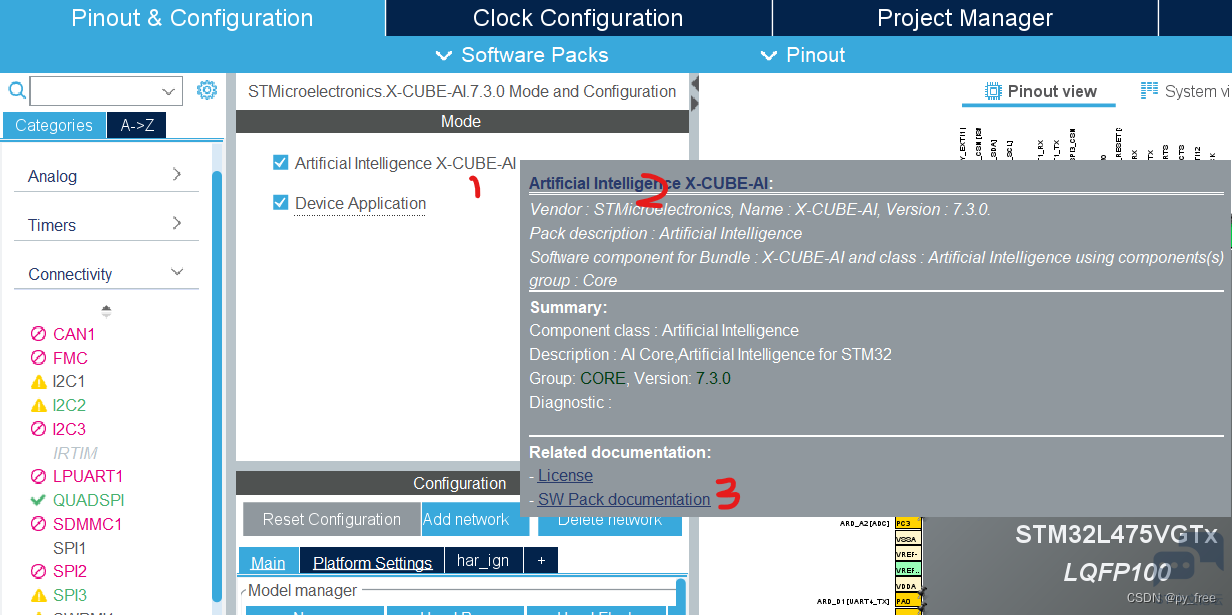
有详细的文档资料:

或者也可以从cube.AI安装目录直接进入,例如:D:\workForSoftware\STM32CubeMX\Repository\Packs\STMicroelectronics\X-CUBE-AI\7.3.0\Documentation
另外,需要注意,开启X-CUBE-AI支持后,其依赖CRC功能,会自动开启CRC。
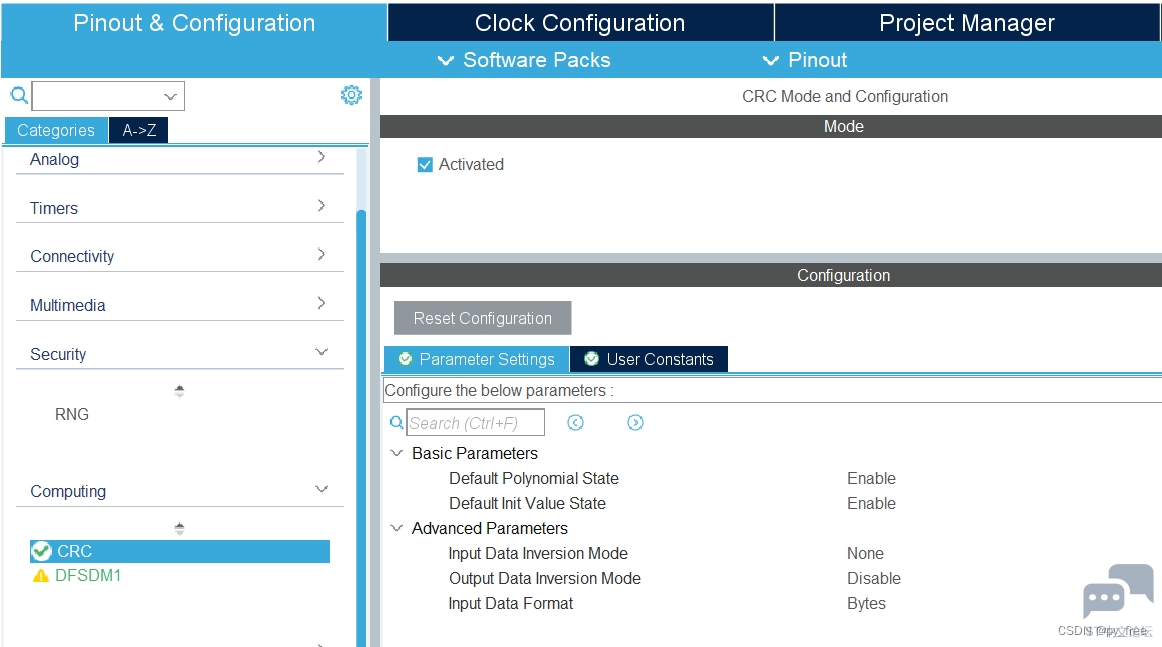
6.3 模型分析与PC端验证
添加(add network)神经网络如下,在3中可以修改神经网络模型名称,在4中选择支持框架及选择模型文件,例如“STM32CubeFunctionPack_SENSING1_V4.0.3\Utilities\AI_Ressources\Training Scripts\HAR\results\2023_Jan_24_14_40_13\har_IGN.h5”,在5、6中,可以选择随机数据进行模型研制,也可以选择生成的研制数据进行验证(前面训练模型时,在RunMe.py文件后面加入语句,输出testx.npy、testy.npy文件):
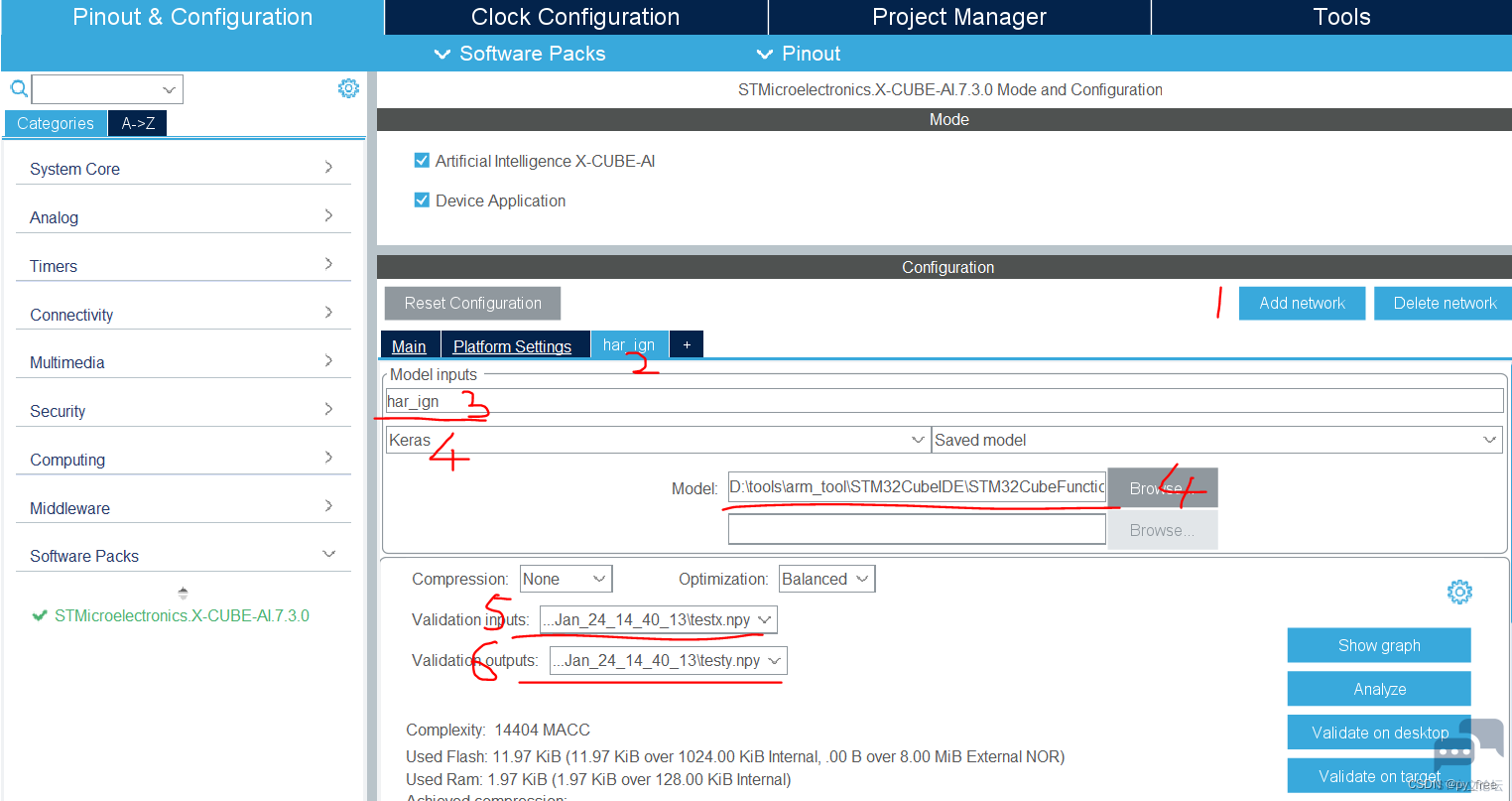
可以点击设置按钮进入,在该页面下可以对神经网络进行更多设置和更详细信息查看,主要是以模型优化为主,本文先保持默认。

点击分析按钮(Analyze),输出该模型相关信息及部署模型需要的计算资源(ram、flash等):
- Analyzing model
- D:/workForSoftware/STM32CubeMX/Repository/Packs/STMicroelectronics/X-CUBE-AI/7.3.0/Utilities/windows/stm32ai analyze --name har_ign -m D:/tools/arm_tool/STM32CubeIDE/STM32CubeFunctionPack_SENSING1_V4.0.3/Utilities/AI_Ressources/Training Scripts/HAR/results/2023_Jan_11_17_50_03/har_IGN.h5 --type keras --compression none --verbosity 1 --workspace C:\Users\py_hp\AppData\Local\Temp\mxAI_workspace465785871649500151581099545474794 --output C:\Users\py_hp\.stm32cubemx\network_output --allocate-inputs --allocate-outputs
- Neural Network Tools for STM32AI v1.6.0 (STM.ai v7.3.0-RC5)
- Exec/report summary (analyze)
- ---------------------------------------------------------------------------------------------------------------------------------------------------------------------------------
- model file : D:\tools\arm_tool\STM32CubeIDE\STM32CubeFunctionPack_SENSING1_V4.0.3\Utilities\AI_Ressources\Training Scripts\HAR\results\2023_Jan_11_17_50_03\har_IGN.h5
- type : keras
- c_name : har_ign
- compression : none
- options : allocate-inputs, allocate-outputs
- optimization : balanced
- target/series : generic
- workspace dir : C:\Users\py_hp\AppData\Local\Temp\mxAI_workspace465785871649500151581099545474794
- output dir : C:\Users\py_hp\.stm32cubemx\network_output
- model_fmt : float
- model_name : har_IGN
- model_hash : ff0080dbe395a3d8fd3f63243d2326d5
- params # : 3,064 items (11.97 KiB)
- ---------------------------------------------------------------------------------------------------------------------------------------------------------------------------------
- input 1/1 : 'input_0' (domain:activations/**default**)
- : 72 items, 288 B, ai_float, float, (1,24,3,1)
- output 1/1 : 'dense_2' (domain:activations/**default**)
- : 4 items, 16 B, ai_float, float, (1,1,1,4)
- macc : 14,404
- weights (ro) : 12,256 B (11.97 KiB) (1 segment)
- activations (rw) : 2,016 B (1.97 KiB) (1 segment) *
- ram (total) : 2,016 B (1.97 KiB) = 2,016 + 0 + 0
- ---------------------------------------------------------------------------------------------------------------------------------------------------------------------------------
- (*) 'input'/'output' buffers can be used from the activations buffer
- Model name - har_IGN ['input_0'] ['dense_2']
- ------------------------------------------------------------------------------------------------------
- id layer (original) oshape param/size macc connected to
- ------------------------------------------------------------------------------------------------------
- 0 input_0 (None) [b:None,h:24,w:3,c:1]
- conv2d_1_conv2d (Conv2D) [b:None,h:9,w:3,c:24] 408/1,632 10,392 input_0
- conv2d_1 (Conv2D) [b:None,h:9,w:3,c:24] 648 conv2d_1_conv2d
- ------------------------------------------------------------------------------------------------------
- 1 max_pooling2d_1 (MaxPooling2D) [b:None,h:3,w:3,c:24] 648 conv2d_1
- ------------------------------------------------------------------------------------------------------
- 2 flatten_1 (Flatten) [b:None,c:216] max_pooling2d_1
- ------------------------------------------------------------------------------------------------------
- 3 dense_1_dense (Dense) [b:None,c:12] 2,604/10,416 2,604 flatten_1
- ------------------------------------------------------------------------------------------------------
- 5 dense_2_dense (Dense) [b:None,c:4] 52/208 52 dense_1_dense
- dense_2 (Dense) [b:None,c:4] 60 dense_2_dense
- ------------------------------------------------------------------------------------------------------
- model/c-model: macc=14,404/14,404 weights=12,256/12,256 activations=--/2,016 io=--/0
- Number of operations per c-layer
- -----------------------------------------------------------------------------------
- c_id m_id name (type) #op (type)
- -----------------------------------------------------------------------------------
- 0 1 conv2d_1_conv2d (optimized_conv2d) 11,688 (smul_f32_f32)
- 1 3 dense_1_dense (dense) 2,604 (smul_f32_f32)
- 2 5 dense_2_dense (dense) 52 (smul_f32_f32)
- 3 5 dense_2 (nl) 60 (op_f32_f32)
- -----------------------------------------------------------------------------------
- total 14,404
- Number of operation types
- ---------------------------------------------
- smul_f32_f32 14,344 99.6%
- op_f32_f32 60 0.4%
- Complexity report (model)
- ------------------------------------------------------------------------------------
- m_id name c_macc c_rom c_id
- ------------------------------------------------------------------------------------
- 1 max_pooling2d_1 |||||||||||||||| 81.1% ||| 13.3% [0]
- 3 dense_1_dense |||| 18.1% |||||||||||||||| 85.0% [1]
- 5 dense_2_dense | 0.8% | 1.7% [2, 3]
- ------------------------------------------------------------------------------------
- macc=14,404 weights=12,256 act=2,016 ram_io=0
- Creating txt report file C:\Users\py_hp\.stm32cubemx\network_output\har_ign_analyze_report.txt
- elapsed time (analyze): 7.692s
- Getting Flash and Ram size used by the library
- Model file: har_IGN.h5
- Total Flash: 29880 B (29.18 KiB)
- Weights: 12256 B (11.97 KiB)
- Library: 17624 B (17.21 KiB)
- Total Ram: 4000 B (3.91 KiB)
- Activations: 2016 B (1.97 KiB)
- Library: 1984 B (1.94 KiB)
- Input: 288 B (included in Activations)
- Output: 16 B (included in Activations)
- Done
- Analyze complete on AI model
复制代码
点击PC桌面验证按钮(validation on desktop),对训练模型进行验证,主要是验证原始模型和转为c语言支持的模型时,验证前后计算资源、模型精度等差异情况,验证数据就是我们刚指定的testx.npy、testy.npy文件。
- Starting AI validation on desktop with custom dataset : D:\tools\arm_tool\STM32CubeIDE\STM32CubeFunctionPack_SENSING1_V4.0.3\Utilities\AI_Ressources\Training Scripts\HAR\results\2023_Jan_24_14_40_13\testx.npy...
- D:/workForSoftware/STM32CubeMX/Repository/Packs/STMicroelectronics/X-CUBE-AI/7.3.0/Utilities/windows/stm32ai validate --name har_ign -m D:/tools/arm_tool/STM32CubeIDE/STM32CubeFunctionPack_SENSING1_V4.0.3/Utilities/AI_Ressources/Training Scripts/HAR/results/2023_Jan_11_17_50_03/har_IGN.h5 --type keras --compression none --verbosity 1 --workspace C:\Users\py_hp\AppData\Local\Temp\mxAI_workspace46601041973700012072836595678733048 --output C:\Users\py_hp\.stm32cubemx\network_output --allocate-inputs --allocate-outputs --valoutput D:/tools/arm_tool/STM32CubeIDE/STM32CubeFunctionPack_SENSING1_V4.0.3/Utilities/AI_Ressources/Training Scripts/HAR/results/2023_Jan_24_14_40_13/testy.npy --valinput D:/tools/arm_tool/STM32CubeIDE/STM32CubeFunctionPack_SENSING1_V4.0.3/Utilities/AI_Ressources/Training Scripts/HAR/results/2023_Jan_24_14_40_13/testx.npy
- Neural Network Tools for STM32AI v1.6.0 (STM.ai v7.3.0-RC5)
- Copying the AI runtime files to the user workspace: C:\Users\py_hp\AppData\Local\Temp\mxAI_workspace46601041973700012072836595678733048\inspector_har_ign\workspace
- Exec/report summary (validate)
- ---------------------------------------------------------------------------------------------------------------------------------------------------------------------------------
- model file : D:\tools\arm_tool\STM32CubeIDE\STM32CubeFunctionPack_SENSING1_V4.0.3\Utilities\AI_Ressources\Training Scripts\HAR\results\2023_Jan_11_17_50_03\har_IGN.h5
- type : keras
- c_name : har_ign
- compression : none
- options : allocate-inputs, allocate-outputs
- optimization : balanced
- target/series : generic
- workspace dir : C:\Users\py_hp\AppData\Local\Temp\mxAI_workspace46601041973700012072836595678733048
- output dir : C:\Users\py_hp\.stm32cubemx\network_output
- vinput files : D:\tools\arm_tool\STM32CubeIDE\STM32CubeFunctionPack_SENSING1_V4.0.3\Utilities\AI_Ressources\Training Scripts\HAR\results\2023_Jan_24_14_40_13\testx.npy
- voutput files : D:\tools\arm_tool\STM32CubeIDE\STM32CubeFunctionPack_SENSING1_V4.0.3\Utilities\AI_Ressources\Training Scripts\HAR\results\2023_Jan_24_14_40_13\testy.npy
- model_fmt : float
- model_name : har_IGN
- model_hash : ff0080dbe395a3d8fd3f63243d2326d5
- params # : 3,064 items (11.97 KiB)
- ---------------------------------------------------------------------------------------------------------------------------------------------------------------------------------
- input 1/1 : 'input_0' (domain:activations/**default**)
- : 72 items, 288 B, ai_float, float, (1,24,3,1)
- output 1/1 : 'dense_2' (domain:activations/**default**)
- : 4 items, 16 B, ai_float, float, (1,1,1,4)
- macc : 14,404
- weights (ro) : 12,256 B (11.97 KiB) (1 segment)
- activations (rw) : 2,016 B (1.97 KiB) (1 segment) *
- ram (total) : 2,016 B (1.97 KiB) = 2,016 + 0 + 0
- ---------------------------------------------------------------------------------------------------------------------------------------------------------------------------------
- (*) 'input'/'output' buffers can be used from the activations buffer
- Setting validation data...
- loading file: D:\tools\arm_tool\STM32CubeIDE\STM32CubeFunctionPack_SENSING1_V4.0.3\Utilities\AI_Ressources\Training Scripts\HAR\results\2023_Jan_24_14_40_13\testx.npy
- - samples are reshaped: (12806, 24, 3, 1) -> (12806, 24, 3, 1)
- loading file: D:\tools\arm_tool\STM32CubeIDE\STM32CubeFunctionPack_SENSING1_V4.0.3\Utilities\AI_Ressources\Training Scripts\HAR\results\2023_Jan_24_14_40_13\testy.npy
- - samples are reshaped: (12806, 4) -> (12806, 1, 1, 4)
- I[1]: (12806, 24, 3, 1)/float32, min/max=[-26.319, 32.844], mean/std=[0.075, 5.034], input_0
- O[1]: (12806, 1, 1, 4)/float32, min/max=[0.000, 1.000], mean/std=[0.250, 0.433], dense_2
- Running the STM AI c-model (AI RUNNER)...(name=har_ign, mode=x86)
- X86 shared lib (C:\Users\py_hp\AppData\Local\Temp\mxAI_workspace46601041973700012072836595678733048\inspector_har_ign\workspace\lib\libai_har_ign.dll) ['har_ign']
- Summary "har_ign" - ['har_ign']
- --------------------------------------------------------------------------------
- inputs/outputs : 1/1
- input_1 : (1,24,3,1), float32, 288 bytes, in activations buffer
- output_1 : (1,1,1,4), float32, 16 bytes, in activations buffer
- n_nodes : 4
- compile_datetime : Jan 25 2023 22:55:51 (Wed Jan 25 22:55:47 2023)
- activations : 2016
- weights : 12256
- macc : 14404
- --------------------------------------------------------------------------------
- runtime : STM.AI 7.3.0 (Tools 7.3.0)
- capabilities : ['IO_ONLY', 'PER_LAYER', 'PER_LAYER_WITH_DATA']
- device : AMD64 Intel64 Family 6 Model 158 Stepping 9, GenuineIntel (Windows)
- --------------------------------------------------------------------------------
- STM.IO: 0%| | 0/12806 [00:00<?, ?it/s]
- STM.IO: 11%|█ | 1424/12806 [00:00<00:00, 14136.31it/s]
- STM.IO: 14%|█▍ | 1849/12806 [00:00<00:04, 2293.62it/s]
- STM.IO: 17%|█▋ | 2170/12806 [00:00<00:05, 1774.74it/s]
- STM.IO: 19%|█▉ | 2429/12806 [00:01<00:06, 1520.26it/s]
- STM.IO: 21%|██ | 2645/12806 [00:01<00:07, 1348.30it/s]
- STM.IO: 22%|██▏ | 2828/12806 [00:01<00:07, 1291.67it/s]
- STM.IO: 23%|██▎ | 2992/12806 [00:01<00:07, 1245.52it/s]
- STM.IO: 25%|██▍ | 3141/12806 [00:01<00:08, 1194.67it/s]
- STM.IO: 26%|██▌ | 3278/12806 [00:01<00:08, 1107.82it/s]
- STM.IO: 27%|██▋ | 3407/12806 [00:02<00:08, 1154.55it/s]
- STM.IO: 28%|██▊ | 3548/12806 [00:02<00:07, 1218.70it/s]
- STM.IO: 29%|██▊ | 3678/12806 [00:02<00:07, 1175.60it/s]
- STM.IO: 30%|██▉ | 3811/12806 [00:02<00:07, 1215.67it/s]
- STM.IO: 31%|███ | 3938/12806 [00:02<00:07, 1139.58it/s]
- STM.IO: 32%|███▏ | 4075/12806 [00:02<00:07, 1197.83it/s]
- STM.IO: 33%|███▎ | 4199/12806 [00:02<00:07, 1207.70it/s]
- STM.IO: 34%|███▍ | 4323/12806 [00:02<00:07, 1078.59it/s]
- STM.IO: 35%|███▍ | 4451/12806 [00:02<00:07, 1129.92it/s]
- STM.IO: 36%|███▌ | 4590/12806 [00:03<00:06, 1194.76it/s]
- STM.IO: 37%|███▋ | 4718/12806 [00:03<00:06, 1216.59it/s]
- STM.IO: 38%|███▊ | 4843/12806 [00:03<00:06, 1195.77it/s]
- STM.IO: 39%|███▉ | 4965/12806 [00:03<00:06, 1159.48it/s]
- STM.IO: 40%|███▉ | 5083/12806 [00:03<00:06, 1116.81it/s]
- STM.IO: 41%|████ | 5197/12806 [00:03<00:06, 1095.57it/s]
- STM.IO: 41%|████▏ | 5308/12806 [00:03<00:06, 1078.25it/s]
- STM.IO: 42%|████▏ | 5433/12806 [00:03<00:06, 1122.47it/s]
- STM.IO: 43%|████▎ | 5547/12806 [00:03<00:06, 1056.59it/s]
- STM.IO: 44%|████▍ | 5655/12806 [00:04<00:06, 1055.01it/s]
- STM.IO: 45%|████▍ | 5762/12806 [00:04<00:06, 1035.74it/s]
- STM.IO: 46%|████▌ | 5867/12806 [00:04<00:06, 1022.60it/s]
- STM.IO: 47%|████▋ | 5981/12806 [00:04<00:06, 1053.06it/s]
- STM.IO: 48%|████▊ | 6098/12806 [00:04<00:06, 1083.31it/s]
- STM.IO: 48%|████▊ | 6208/12806 [00:04<00:06, 1025.35it/s]
- STM.IO: 49%|████▉ | 6312/12806 [00:04<00:06, 952.27it/s]
- STM.IO: 50%|█████ | 6410/12806 [00:04<00:07, 910.42it/s]
- STM.IO: 51%|█████ | 6509/12806 [00:04<00:06, 930.92it/s]
- STM.IO: 52%|█████▏ | 6620/12806 [00:04<00:06, 976.37it/s]
- STM.IO: 52%|█████▏ | 6720/12806 [00:05<00:06, 926.81it/s]
- STM.IO: 53%|█████▎ | 6818/12806 [00:05<00:06, 940.17it/s]
- STM.IO: 54%|█████▍ | 6914/12806 [00:05<00:06, 930.36it/s]
- STM.IO: 55%|█████▍ | 7008/12806 [00:05<00:06, 852.84it/s]
- STM.IO: 55%|█████▌ | 7106/12806 [00:05<00:06, 885.63it/s]
- STM.IO: 56%|█████▌ | 7197/12806 [00:05<00:06, 805.83it/s]
- STM.IO: 57%|█████▋ | 7299/12806 [00:05<00:06, 858.49it/s]
- STM.IO: 58%|█████▊ | 7388/12806 [00:05<00:07, 744.49it/s]
- STM.IO: 58%|█████▊ | 7473/12806 [00:06<00:07, 755.34it/s]
- STM.IO: 59%|█████▉ | 7560/12806 [00:06<00:06, 785.88it/s]
- STM.IO: 60%|█████▉ | 7642/12806 [00:06<00:06, 782.78it/s]
- STM.IO: 60%|██████ | 7723/12806 [00:06<00:06, 768.90it/s]
- STM.IO: 61%|██████ | 7825/12806 [00:06<00:06, 828.66it/s]
- STM.IO: 62%|██████▏ | 7937/12806 [00:06<00:05, 897.30it/s]
- STM.IO: 63%|██████▎ | 8033/12806 [00:06<00:05, 913.23it/s]
- STM.IO: 63%|██████▎ | 8127/12806 [00:06<00:05, 913.79it/s]
- STM.IO: 64%|██████▍ | 8254/12806 [00:06<00:04, 994.44it/s]
- STM.IO: 65%|██████▌ | 8358/12806 [00:06<00:04, 1005.50it/s]
- STM.IO: 66%|██████▌ | 8466/12806 [00:07<00:04, 1024.62it/s]
- STM.IO: 67%|██████▋ | 8579/12806 [00:07<00:04, 1052.03it/s]
- STM.IO: 68%|██████▊ | 8712/12806 [00:07<00:03, 1111.93it/s]
- STM.IO: 69%|██████▉ | 8826/12806 [00:07<00:03, 1044.19it/s]
- STM.IO: 70%|██████▉ | 8933/12806 [00:07<00:03, 1005.29it/s]
- STM.IO: 71%|███████ | 9036/12806 [00:07<00:03, 1010.21it/s]
- STM.IO: 71%|███████▏ | 9150/12806 [00:07<00:03, 1043.83it/s]
- STM.IO: 72%|███████▏ | 9277/12806 [00:07<00:03, 1100.57it/s]
- STM.IO: 73%|███████▎ | 9404/12806 [00:07<00:02, 1144.16it/s]
- STM.IO: 74%|███████▍ | 9521/12806 [00:08<00:02, 1135.98it/s]
- STM.IO: 75%|███████▌ | 9648/12806 [00:08<00:02, 1170.75it/s]
- STM.IO: 76%|███████▋ | 9780/12806 [00:08<00:02, 1209.41it/s]
- STM.IO: 77%|███████▋ | 9903/12806 [00:08<00:02, 1184.92it/s]
- STM.IO: 78%|███████▊ | 10032/12806 [00:08<00:02, 1212.12it/s]
- STM.IO: 79%|███████▉ | 10155/12806 [00:08<00:02, 1214.79it/s]
- STM.IO: 80%|████████ | 10278/12806 [00:08<00:02, 1096.01it/s]
- STM.IO: 81%|████████ | 10391/12806 [00:08<00:02, 1100.40it/s]
- STM.IO: 82%|████████▏ | 10506/12806 [00:08<00:02, 1112.34it/s]
- STM.IO: 83%|████████▎ | 10619/12806 [00:09<00:02, 1035.66it/s]
- STM.IO: 84%|████████▎ | 10725/12806 [00:09<00:02, 914.43it/s]
- STM.IO: 84%|████████▍ | 10821/12806 [00:09<00:02, 889.74it/s]
- STM.IO: 85%|████████▌ | 10920/12806 [00:09<00:02, 915.76it/s]
- STM.IO: 86%|████████▌ | 11014/12806 [00:09<00:02, 819.91it/s]
- STM.IO: 87%|████████▋ | 11100/12806 [00:09<00:02, 738.28it/s]
- STM.IO: 87%|████████▋ | 11178/12806 [00:09<00:02, 740.24it/s]
- STM.IO: 88%|████████▊ | 11255/12806 [00:09<00:02, 657.58it/s]
- STM.IO: 89%|████████▊ | 11364/12806 [00:10<00:02, 702.16it/s]
- STM.IO: 89%|████████▉ | 11455/12806 [00:10<00:01, 752.49it/s]
- STM.IO: 90%|█████████ | 11548/12806 [00:10<00:01, 794.66it/s]
- STM.IO: 91%|█████████ | 11631/12806 [00:10<00:01, 796.56it/s]
- STM.IO: 92%|█████████▏| 11748/12806 [00:10<00:01, 879.46it/s]
- STM.IO: 93%|█████████▎| 11853/12806 [00:10<00:01, 922.73it/s]
- STM.IO: 93%|█████████▎| 11949/12806 [00:10<00:00, 895.23it/s]
- STM.IO: 94%|█████████▍| 12049/12806 [00:10<00:00, 922.41it/s]
- STM.IO: 95%|█████████▍| 12163/12806 [00:10<00:00, 976.60it/s]
- STM.IO: 96%|█████████▌| 12280/12806 [00:10<00:00, 1025.50it/s]
- STM.IO: 97%|█████████▋| 12412/12806 [00:11<00:00, 1096.80it/s]
- STM.IO: 98%|█████████▊| 12525/12806 [00:11<00:00, 1072.91it/s]
- STM.IO: 99%|█████████▉| 12663/12806 [00:11<00:00, 1147.57it/s]
- STM.IO: 100%|█████████▉| 12781/12806 [00:11<00:00, 1118.51it/s]
- Results for 12806 inference(s) - average per inference
- device : AMD64 Intel64 Family 6 Model 158 Stepping 9, GenuineIntel (Windows)
- duration : 0.057ms
- c_nodes : 4
- c_id m_id desc output ms %
- -------------------------------------------------------------------------------
- 0 1 Conv2dPool (0x109) (1,3,3,24)/float32/864B 0.049 86.5%
- 1 3 Dense (0x104) (1,1,1,12)/float32/48B 0.005 9.1%
- 2 5 Dense (0x104) (1,1,1,4)/float32/16B 0.001 1.8%
- 3 5 NL (0x107) (1,1,1,4)/float32/16B 0.001 2.5%
- -------------------------------------------------------------------------------
- 0.057 ms
- NOTE: duration and exec time per layer is just an indication. They are dependent of the HOST-machine work-load.
- Running the Keras model...
- Saving validation data...
- output directory: C:\Users\py_hp\.stm32cubemx\network_output
- creating C:\Users\py_hp\.stm32cubemx\network_output\har_ign_val_io.npz
- m_outputs_1: (12806, 1, 1, 4)/float32, min/max=[0.000, 1.000], mean/std=[0.250, 0.376], dense_2
- c_outputs_1: (12806, 1, 1, 4)/float32, min/max=[0.000, 1.000], mean/std=[0.250, 0.376], dense_2
- Computing the metrics...
- Accuracy report #1 for the generated x86 C-model
- ----------------------------------------------------------------------------------------------------
- notes: - computed against the provided ground truth values
- - 12806 samples (4 items per sample)
- acc=86.72%, rmse=0.224433631, mae=0.096160948, l2r=0.496649474, nse=73.14%
- 4 classes (12806 samples)
- ----------------------------
- C0 3678 . 62 41
- C1 . 1124 14 .
- C2 254 10 1806 662
- C3 66 . 592 4497
- Accuracy report #1 for the reference model
- ----------------------------------------------------------------------------------------------------
- notes: - computed against the provided ground truth values
- - 12806 samples (4 items per sample)
- acc=86.72%, rmse=0.224433631, mae=0.096160948, l2r=0.496649474, nse=73.14%
- 4 classes (12806 samples)
- ----------------------------
- C0 3678 . 62 41
- C1 . 1124 14 .
- C2 254 10 1806 662
- C3 66 . 592 4497
- Cross accuracy report #1 (reference vs C-model)
- ----------------------------------------------------------------------------------------------------
- notes: - the output of the reference model is used as ground truth/reference value
- - 12806 samples (4 items per sample)
- acc=100.00%, rmse=0.000000063, mae=0.000000024, l2r=0.000000139, nse=100.00%
- 4 classes (12806 samples)
- ----------------------------
- C0 3998 . . .
- C1 . 1134 . .
- C2 . . 2474 .
- C3 . . . 5200
- Evaluation report (summary)
- ----------------------------------------------------------------------------------------------------------------------------------------------------------
- Output acc rmse mae l2r mean std nse tensor
- ----------------------------------------------------------------------------------------------------------------------------------------------------------
- x86 c-model #1 86.72% 0.224433631 0.096160948 0.496649474 -0.000000000 0.224435821 0.731362987 dense_2, ai_float, (1,1,1,4), m_id=[5]
- original model #1 86.72% 0.224433631 0.096160948 0.496649474 -0.000000001 0.224435821 0.731362987 dense_2, ai_float, (1,1,1,4), m_id=[5]
- X-cross #1 100.00% 0.000000063 0.000000024 0.000000139 0.000000000 0.000000063 1.000000000 dense_2, ai_float, (1,1,1,4), m_id=[5]
- ----------------------------------------------------------------------------------------------------------------------------------------------------------
- rmse : Root Mean Squared Error
- mae : Mean Absolute Error
- l2r : L2 relative error
- nse : Nash-Sutcliffe efficiency criteria
- Creating txt report file C:\Users\py_hp\.stm32cubemx\network_output\har_ign_validate_report.txt
- elapsed time (validate): 26.458s
- Validation
复制代码
6.4 c语言神经网络模型生成及源码输出
将开发板重新选择ST-LINK连接(5-6跳线帽拔出,插入1-2跳线中)
为了后续源码讲解方便,只生产c语言的神经网络模型源码,不输出应用示例程序(有个弊端就是在新建程序加载到开发板后,validation on target功能无法使用),如下图所示。
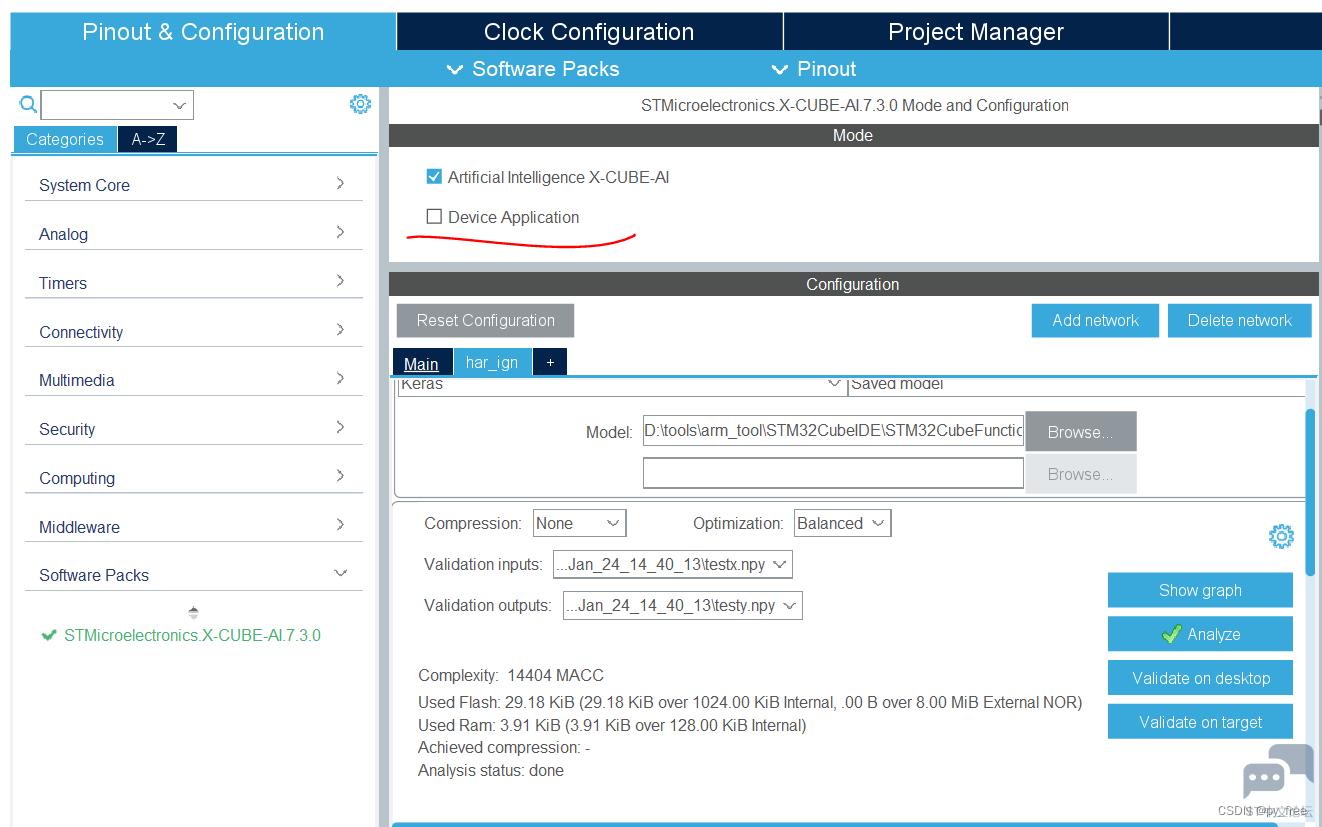
配置输出工程

七、c语言神经网络模型使用
7.1 C语言神经网络模型源文件
在cubeMX配置神经网络模型时,指明了名称是har_ign,会生成如下文件har_ign.h/c、har_ign_data.h/c、har_ign_data_params.h/c、har_ign_config.h这些源码文件就是转换后的c语言神经网络模型,提供了一系列的API,这些API通过调用cube.AI软件包的内置功能,工程实现了神经网络计算功能:
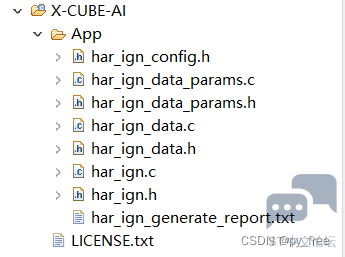
其中har_ign_generate_report.txt文件是生成c语言神经网络模型的过程记录。

7.2 串口功能自定义实现
由于本文没有选择生成配套的应用程序代码,因此串口功能还需要自己实现,因此我移植了串口功能代码,在工程目录下,创建了ICore源目录,并创建print、usart子目录,分别在两个子目录加入print.h/c和usart.h/c源码。

print.h如下:
- #ifndef INC_RETARGET_H_
- #define INC_RETARGET_H_
- #include "stm32l4xx_hal.h"
- #include "stdio.h"//用于printf函数串口重映射
- #include <sys/stat.h>
- void ResetPrintInit(UART_HandleTypeDef *huart);
- int _isatty(int fd);
- int _write(int fd, char* ptr, int len);
- int _close(int fd);
- int _lseek(int fd, int ptr, int dir);
- int _read(int fd, char* ptr, int len);
- int _fstat(int fd, struct stat* st);
- #endif /* INC_RETARGET_H_ */
复制代码
print.c如下:
- #include <_ansi.h>
- #include <_syslist.h>
- #include <errno.h>
- #include <sys/time.h>
- #include <sys/times.h>
- #include <limits.h>
- #include <signal.h>
- #include <stdint.h>
- #include <stdio.h>
- #include "print.h"
- #if !defined(OS_USE_SEMIHOSTING)
- #define STDIN_FILENO 0
- #define STDOUT_FILENO 1
- #define STDERR_FILENO 2
- UART_HandleTypeDef *gHuart;
- void ResetPrintInit(UART_HandleTypeDef *huart) {
- gHuart = huart;
- /* Disable I/O buffering for STDOUT stream, so that
- * chars are sent out as soon as they are printed. */
- setvbuf(stdout, NULL, _IONBF, 0);
- }
- int _isatty(int fd) {
- if (fd >= STDIN_FILENO && fd <= STDERR_FILENO)
- return 1;
- errno = EBADF;
- return 0;
- }
- int _write(int fd, char* ptr, int len) {
- HAL_StatusTypeDef hstatus;
- if (fd == STDOUT_FILENO || fd == STDERR_FILENO) {
- hstatus = HAL_UART_Transmit(gHuart, (uint8_t *) ptr, len, HAL_MAX_DELAY);
- if (hstatus == HAL_OK)
- return len;
- else
- return EIO;
- }
- errno = EBADF;
- return -1;
- }
- int _close(int fd) {
- if (fd >= STDIN_FILENO && fd <= STDERR_FILENO)
- return 0;
- errno = EBADF;
- return -1;
- }
- int _lseek(int fd, int ptr, int dir) {
- (void) fd;
- (void) ptr;
- (void) dir;
- errno = EBADF;
- return -1;
- }
- int _read(int fd, char* ptr, int len) {
- HAL_StatusTypeDef hstatus;
- if (fd == STDIN_FILENO) {
- hstatus = HAL_UART_Receive(gHuart, (uint8_t *) ptr, 1, HAL_MAX_DELAY);
- if (hstatus == HAL_OK)
- return 1;
- else
- return EIO;
- }
- errno = EBADF;
- return -1;
- }
- int _fstat(int fd, struct stat* st) {
- if (fd >= STDIN_FILENO && fd <= STDERR_FILENO) {
- st->st_mode = S_IFCHR;
- return 0;
- }
- errno = EBADF;
- return 0;
- }
- #endif //#if !defined(OS_USE_SEMIHOSTING)
复制代码
usart.h
- #ifndef INC_USART_H_
- #define INC_USART_H_
- #include "stm32l4xx_hal.h" //HAL库文件声明
- #include <string.h>//用于字符串处理的库
- #include "../print/print.h"//用于printf函数串口重映射
- extern UART_HandleTypeDef huart1;//声明LPUSART的HAL库结构体
- #define USART_REC_LEN 256//定义LPUSART最大接收字节数
- extern uint8_t USART_RX_BUF[USART_REC_LEN];//接收缓冲,最大USART_REC_LEN个字节.末字节为换行符
- extern uint16_t USART_RX_STA;//接收状态标记
- extern uint8_t USART_NewData;//当前串口中断接收的1个字节数据的缓存
- void HAL_UART_RxCpltCallback(UART_HandleTypeDef *huart);//串口中断回调函数声明
- #endif /* INC_USART_H_ */
复制代码
usart.c如下:
- #include "usart.h"
- uint8_t USART_RX_BUF[USART_REC_LEN];//接收缓冲,最大USART_REC_LEN个字节.末字节为换行符
- /*
- * bit15:接收到回车(0x0d)时设置HLPUSART_RX_STA|=0x8000;
- * bit14:接收溢出标志,数据超出缓存长度时,设置HLPUSART_RX_STA|=0x4000;
- * bit13:预留
- * bit12:预留
- * bit11~0:接收到的有效字节数目(0~4095)
- */
- uint16_t USART_RX_STA=0;接收状态标记//bit15:接收完成标志,bit14:接收到回车(0x0d),bit13~0:接收到的有效字节数目
- uint8_t USART_NewData;//当前串口中断接收的1个字节数据的缓存
- void HAL_UART_RxCpltCallback(UART_HandleTypeDef *huart)//串口中断回调函数
- {
- if(huart ==&huart1)//判断中断来源(串口1:USB转串口)
- {
- if(USART_NewData==0x0d){//回车标记
- USART_RX_STA|=0x8000;//标记接到回车
- }else{
- if((USART_RX_STA&0X0FFF)<USART_REC_LEN){
- USART_RX_BUF[USART_RX_STA&0X0FFF]=USART_NewData; //将收到的数据放入数组
- USART_RX_STA++; //数据长度计数加1
- }else{
- USART_RX_STA|=0x4000;//数据超出缓存长度,标记溢出
- }
- }
- HAL_UART_Receive_IT(&huart1,(uint8_t *)&USART_NewData,1); //再开启接收中断
- }
- }
复制代码
7.3 c语言神经网络模型API使用
先不管底层机理,本文给下面代码,看看如何实现这些API调用的,在main.c文件中,通过aiInit函数,实现har_ign模型初始化,并打印模型相关信息。在主函数循环体中,通过串口输入信息,获得数据生成因子,调用acquire_and_process_data进行输入数据生成,然后调用aiRun,并传入生成数据及输出缓存,进行神经网络模型调用。然后调用post_process打印输出信息。
- /* USER CODE END Header */
- /* Includes ------------------------------------------------------------------*/
- #include "main.h"
- #include "crc.h"
- #include "dfsdm.h"
- #include "i2c.h"
- #include "quadspi.h"
- #include "spi.h"
- #include "usart.h"
- #include "usb_otg.h"
- #include "gpio.h"
- /* Private includes ----------------------------------------------------------*/
- /* USER CODE BEGIN Includes */
- #include "../../ICore/print/print.h"
- #include "../../ICore/usart/usart.h"
- #include "../../X-CUBE-AI/app/har_ign.h"
- #include "../../X-CUBE-AI/app/har_ign_data.h"
- /* USER CODE END Includes */
- /* Private typedef -----------------------------------------------------------*/
- /* USER CODE BEGIN PTD */
- /* USER CODE END PTD */
- /* Private define ------------------------------------------------------------*/
- /* USER CODE BEGIN PD */
- /* USER CODE END PD */
- /* Private macro -------------------------------------------------------------*/
- /* USER CODE BEGIN PM */
- /* USER CODE END PM */
- /* Private variables ---------------------------------------------------------*/
- /* USER CODE BEGIN PV */
- /* USER CODE END PV */
- /* Private function prototypes -----------------------------------------------*/
- void SystemClock_Config(void);
- /* USER CODE BEGIN PFP */
- /* USER CODE END PFP */
- /* Private user code ---------------------------------------------------------*/
- /* USER CODE BEGIN 0 */
- /* Global handle to reference the instantiated C-model */
- static ai_handle network = AI_HANDLE_NULL;
- /* Global c-array to handle the activations buffer */
- AI_ALIGNED(32)
- static ai_u8 activations[AI_HAR_IGN_DATA_ACTIVATIONS_SIZE];
- /* Array to store the data of the input tensor */
- AI_ALIGNED(32)
- static ai_float in_data[AI_HAR_IGN_IN_1_SIZE];
- /* or static ai_u8 in_data[AI_HAR_IGN_IN_1_SIZE_BYTES]; */
- /* c-array to store the data of the output tensor */
- AI_ALIGNED(32)
- static ai_float out_data[AI_HAR_IGN_OUT_1_SIZE];
- /* static ai_u8 out_data[AI_HAR_IGN_OUT_1_SIZE_BYTES]; */
- /* Array of pointer to manage the model's input/output tensors */
- static ai_buffer *ai_input;
- static ai_buffer *ai_output;
- static ai_buffer_format fmt_input;
- static ai_buffer_format fmt_output;
- void buf_print(void)
- {
- printf("in_data:");
- for (int i=0; i<AI_HAR_IGN_IN_1_SIZE; i++)
- {
- printf("%f ",((ai_float*)in_data));
- }
- printf("\n");
- printf("out_data:");
- for (int i=0; i<AI_HAR_IGN_OUT_1_SIZE; i++)
- {
- printf("%f ",((ai_float*)out_data));
- }
- printf("\n");
- }
- void aiPrintBufInfo(const ai_buffer *buffer)
- {
- printf("(%lu, %lu, %lu, %lu)", AI_BUFFER_SHAPE_ELEM(buffer, AI_SHAPE_BATCH),
- AI_BUFFER_SHAPE_ELEM(buffer, AI_SHAPE_HEIGHT),
- AI_BUFFER_SHAPE_ELEM(buffer, AI_SHAPE_WIDTH),
- AI_BUFFER_SHAPE_ELEM(buffer, AI_SHAPE_CHANNEL));
- printf(" buffer_size:%d ", (int)AI_BUFFER_SIZE(buffer));
- }
- void aiPrintDataType(const ai_buffer_format fmt)
- {
- if (AI_BUFFER_FMT_GET_TYPE(fmt) == AI_BUFFER_FMT_TYPE_FLOAT)
- printf("float%d ", (int)AI_BUFFER_FMT_GET_BITS(fmt));
- else if (AI_BUFFER_FMT_GET_TYPE(fmt) == AI_BUFFER_FMT_TYPE_BOOL) {
- printf("bool%d ", (int)AI_BUFFER_FMT_GET_BITS(fmt));
- } else { /* integer type */
- printf("%s%d ", AI_BUFFER_FMT_GET_SIGN(fmt)?"i":"u",
- (int)AI_BUFFER_FMT_GET_BITS(fmt));
- }
- }
- void aiPrintDataInfo(const ai_buffer *buffer,const ai_buffer_format fmt)
- {
- if (buffer->data)
- printf(" @0x%X/%d \n",
- (int)buffer->data,
- (int)AI_BUFFER_BYTE_SIZE(AI_BUFFER_SIZE(buffer), fmt)
- );
- else
- printf(" (User Domain)/%d \n",
- (int)AI_BUFFER_BYTE_SIZE(AI_BUFFER_SIZE(buffer), fmt)
- );
- }
- void aiPrintNetworkInfo(const ai_network_report report)
- {
- printf("Model name : %s\n", report.model_name);
- printf(" model signature : %s\n", report.model_signature);
- printf(" model datetime : %s\r\n", report.model_datetime);
- printf(" compile datetime : %s\r\n", report.compile_datetime);
- printf(" runtime version : %d.%d.%d\r\n",
- report.runtime_version.major,
- report.runtime_version.minor,
- report.runtime_version.micro);
- if (report.tool_revision[0])
- printf(" Tool revision : %s\r\n", (report.tool_revision[0])?report.tool_revision:"");
- printf(" tools version : %d.%d.%d\r\n",
- report.tool_version.major,
- report.tool_version.minor,
- report.tool_version.micro);
- printf(" complexity : %lu MACC\r\n", (unsigned long)report.n_macc);
- printf(" c-nodes : %d\r\n", (int)report.n_nodes);
- printf(" map_activations : %d\r\n", report.map_activations.size);
- for (int idx=0; idx<report.map_activations.size;idx++) {
- const ai_buffer *buffer = &report.map_activations.buffer[idx];
- printf(" [%d] ", idx);
- aiPrintBufInfo(buffer);
- printf("\r\n");
- }
- printf(" map_weights : %d\r\n", report.map_weights.size);
- for (int idx=0; idx<report.map_weights.size;idx++) {
- const ai_buffer *buffer = &report.map_weights.buffer[idx];
- printf(" [%d] ", idx);
- aiPrintBufInfo(buffer);
- printf("\r\n");
- }
- }
- /*
- * Bootstrap
- */
- int aiInit(void) {
- ai_error err;
- /* Create and initialize the c-model */
- const ai_handle acts[] = { activations };
- err = ai_har_ign_create_and_init(&network, acts, NULL);
- if (err.type != AI_ERROR_NONE) {
- printf("ai_error_type:%d,ai_error_code:%d\r\n",err.type,err.code);
- };
- ai_network_report report;
- if (ai_har_ign_get_report(network, &report) != true) {
- printf("ai get report error\n");
- return -1;
- }
- aiPrintNetworkInfo(report);
- /* Reteive pointers to the model's input/output tensors */
- ai_input = ai_har_ign_inputs_get(network, NULL);
- ai_output = ai_har_ign_outputs_get(network, NULL);
- //
- fmt_input = AI_BUFFER_FORMAT(ai_input);
- fmt_output = AI_BUFFER_FORMAT(ai_output);
- printf(" n_inputs/n_outputs : %u/%u\r\n", report.n_inputs,
- report.n_outputs);
- printf("input :");
- aiPrintBufInfo(ai_input);
- aiPrintDataType(fmt_input);
- aiPrintDataInfo(ai_input, fmt_input);
- //
- printf("output :");
- aiPrintBufInfo(ai_output);
- aiPrintDataType(fmt_output);
- aiPrintDataInfo(ai_output, fmt_output);
- return 0;
- }
- int acquire_and_process_data(void *in_data,int factor)
- {
- printf("in_data:");
- for (int i=0; i<AI_HAR_IGN_IN_1_SIZE; i++)
- {
- switch(i%3){
- case 0:
- ((ai_float*)in_data) = -175+(ai_float)(i*factor*1.2)/10.0;
- break;
- case 1:
- ((ai_float*)in_data) = 50+(ai_float)(i*factor*0.6)/100.0;
- break;
- case 2:
- ((ai_float*)in_data) = 975-(ai_float)(i*factor*1.8)/100.0;
- break;
- default:
- break;
- }
- printf("%f ",((ai_float*)in_data));
- }
- printf("\n");
- return 0;
- }
- /*
- * Run inference
- */
- int aiRun(const void *in_data, void *out_data) {
- ai_i32 n_batch;
- ai_error err;
- /* 1 - Update IO handlers with the data payload */
- ai_input[0].data = AI_HANDLE_PTR(in_data);
- ai_output[0].data = AI_HANDLE_PTR(out_data);
- /* 2 - Perform the inference */
- n_batch = ai_har_ign_run(network, &ai_input[0], &ai_output[0]);
- if (n_batch != 1) {
- err = ai_har_ign_get_error(network);
- printf("ai_error_type:%d,ai_error_code:%d\r\n",err.type,err.code);
- };
- return 0;
- }
- int post_process(void *out_data)
- {
- printf("out_data:");
- for (int i=0; i<AI_HAR_IGN_OUT_1_SIZE; i++)
- {
- printf("%f ",((ai_float*)out_data));
- }
- printf("\n");
- return 0;
- }
- /* USER CODE END 0 */
- /**
- * @brief The application entry point.
- * @retval int
- */
- int main(void)
- {
- /* USER CODE BEGIN 1 */
- /* USER CODE END 1 */
- /* MCU Configuration--------------------------------------------------------*/
- /* Reset of all peripherals, Initializes the Flash interface and the Systick. */
- HAL_Init();
- /* USER CODE BEGIN Init */
- /* USER CODE END Init */
- /* Configure the system clock */
- SystemClock_Config();
- /* USER CODE BEGIN SysInit */
- /* USER CODE END SysInit */
- /* Initialize all configured peripherals */
- MX_GPIO_Init();
- MX_DFSDM1_Init();
- MX_I2C2_Init();
- MX_QUADSPI_Init();
- MX_SPI3_Init();
- MX_USART1_UART_Init();
- MX_USART3_UART_Init();
- MX_USB_OTG_FS_PCD_Init();
- MX_CRC_Init();
- /* USER CODE BEGIN 2 */
- ResetPrintInit(&huart1);
- HAL_UART_Receive_IT(&huart1,(uint8_t *)&USART_NewData, 1); //再开启接收中断
- USART_RX_STA = 0;
- aiInit();
- uint8_t factor = 1;
- buf_print();
- /* USER CODE END 2 */
- /* Infinite loop */
- /* USER CODE BEGIN WHILE */
- while (1)
- {
- if(USART_RX_STA&0xC000){//溢出或换行,重新开始
- printf("uart1:%.*s\r\n",USART_RX_STA&0X0FFF, USART_RX_BUF);
- if(strstr((const char*)USART_RX_BUF,(const char*)"test"))
- {
- factor = ((uint8_t)USART_RX_BUF[4]-0x30);
- printf("factor:%d\n",factor);
- acquire_and_process_data(in_data,factor);
- aiRun(in_data, out_data);
- post_process(out_data);
- }
- USART_RX_STA=0;//接收错误,重新开始
- HAL_Delay(100);//等待
- }
- /* USER CODE END WHILE */
- /* USER CODE BEGIN 3 */
- }
- /* USER CODE END 3 */
- }
- //其他生产代码
- .......
复制代码
7.4 编译及程序运行测试
配置工程输出文件格式支持,并设置运行配置:
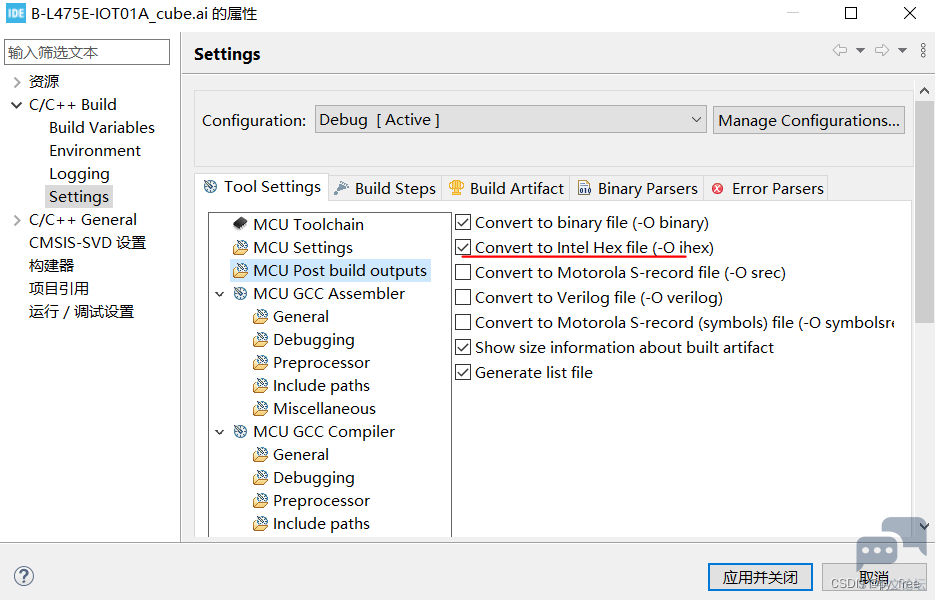
编译及下载程序:

打开串口助手,查看日志输出,发送信息,例如test7,即7作为因子生成输入数据,然后看输出结果。

7.5 补充说明
目前只能说是采用cubeIDE+cube.AI+keras的STM32嵌入式人工智能开发走通了流程,但是串口反馈回来的日志信息是不合理的,因为在数据采集时我们只采集了传感器的三个数值,但在训练模型时,默认的数据输入量是24,显然是不合理的,因此需要还需要重新分析官方提供的HAR训练模型的项目,使得模型训练与采集数据匹配起来,请阅读篇二。
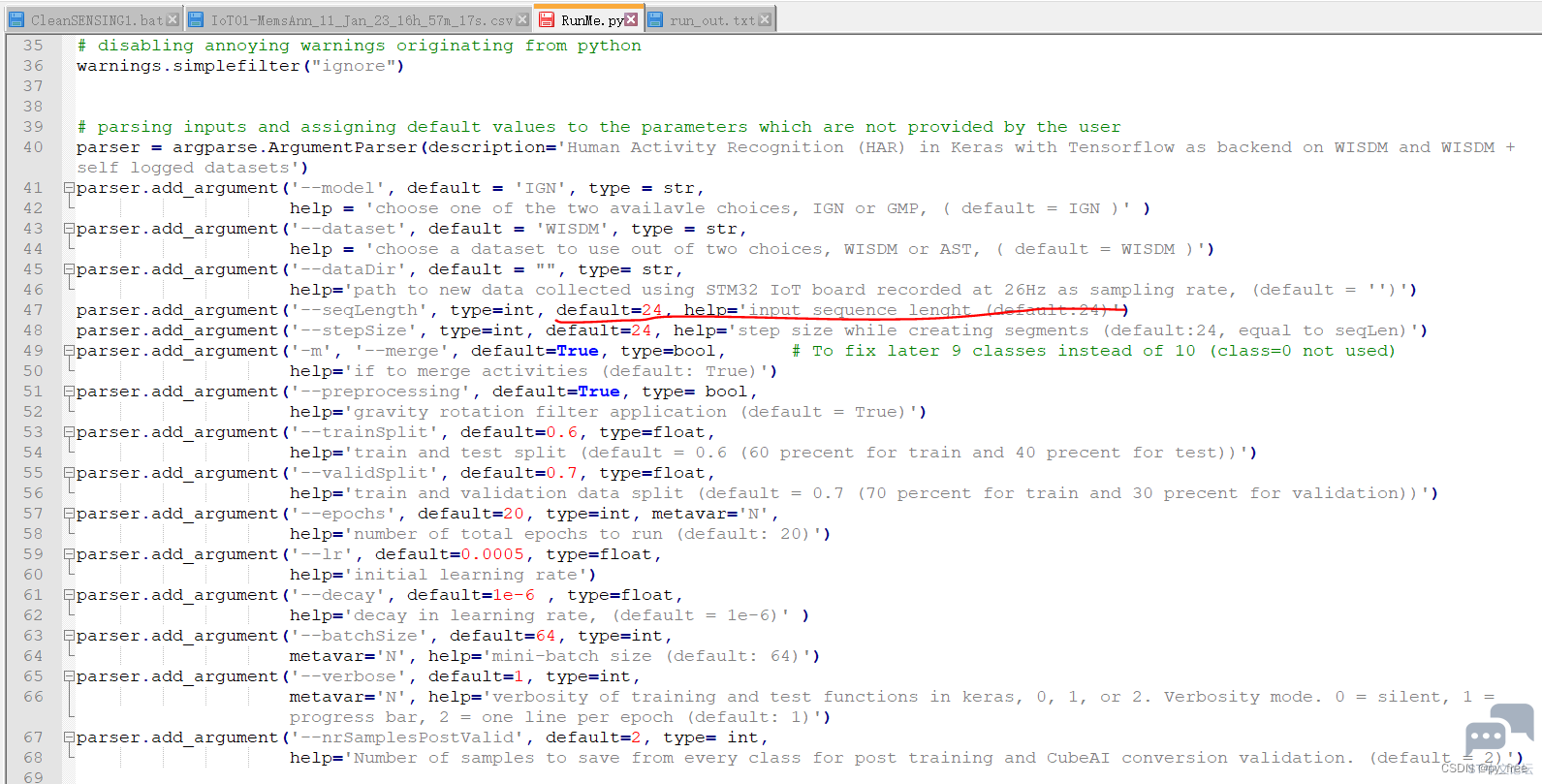
但考虑到官方提供的HAR训练模型的工程项目还是过于复杂,不助于学习和了解cube.AI的真正用法,因此后面将抛弃官方提供的HAR训练模型的项目,自行撰写一个训练模型项目+实际采集数据生成神经网络模型,是的数据输入和输出匹配,并将采用
|